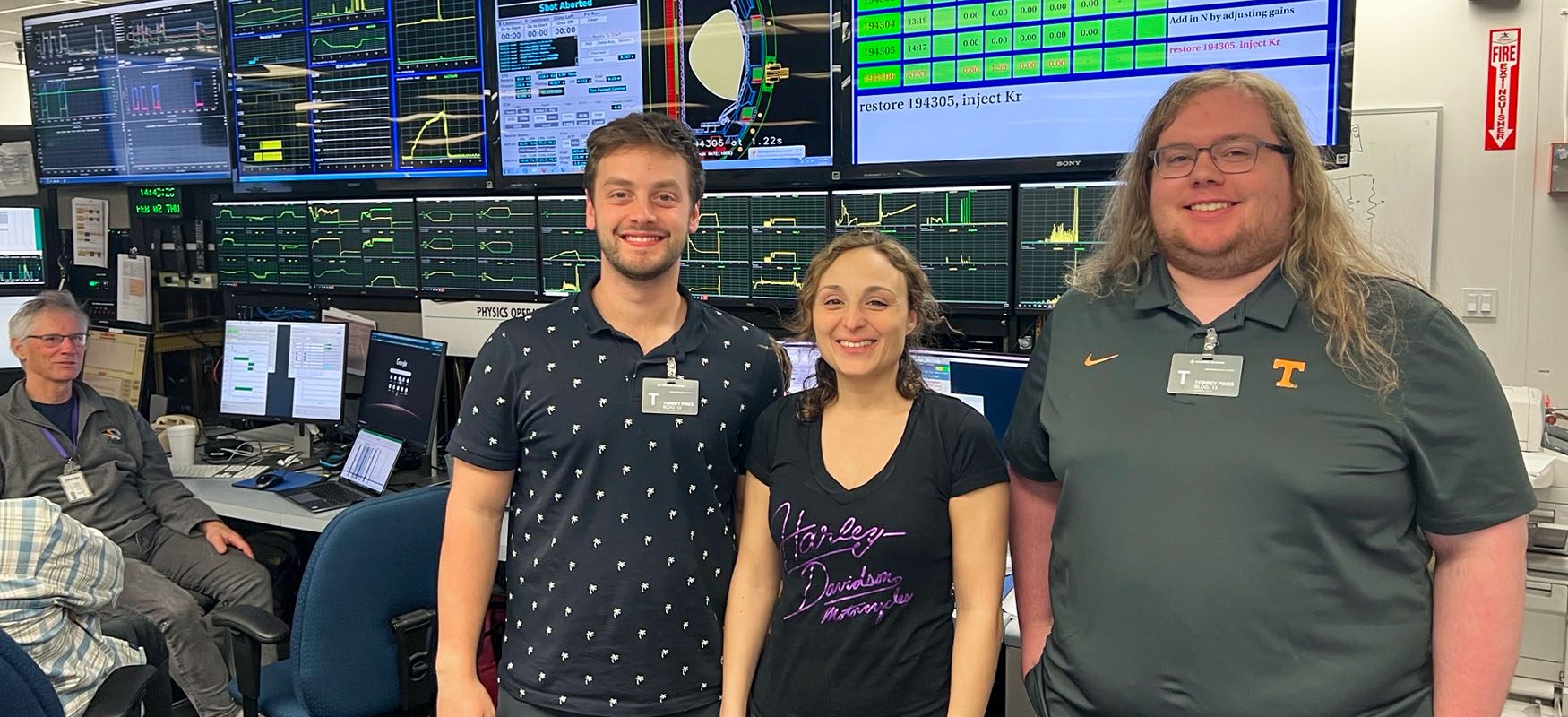Casali, Students Involved in Groundbreaking Global Collaboration
The historical importance of the opportunity wasn’t lost on Zinkle Fellow and Assistant Professor Livia Casali. Although her daughter was only two months old at the time, Casali knew she had to make the trip to the DIII-D National Fusion Facility in San Diego to lead the first-ever experiments at high radiation in the new revolutionary negative triangularity tokamak configuration.
The DIII-D, the largest magnetic fusion user facility in the United States, hosted a month-long fusion research campaign last year utilizing a plasma configuration known as “negative triangularity.” The campaign was organized and conducted to explore the potential benefits of using the configuration to improve exhaust handling and particle confinement to make future fusion energy plants more efficient and cost effective.
The campaign was a global collaboration that included researchers from 15 institutions, including eight universities. Casali and her PhD students, Ray Mattes and Austin Welsh, represented the University of Tennessee. The work is part of Casali’s Department of Energy (DOE) Early Career Award.
Casali brought her newborn daughter and husband on the trip to a city she once called home. DIII-D is an Office of Science scientific user facility, operated by General Atomics for the Department of Energy. Casali worked at General Atomics before joining the UT staff in 2021.
“This is the most revolutionary thing that has happened in the field in the last 20 years. It was really a proud moment for me to have my students there and get to experience a unique experimental campaign and historical moment,” Casali said. “It’s not something that happens every day. It’s really one of the most exciting things I have ever seen since I have been in the field.”
To achieve fusion conditions relevant for energy production, DIII-D’s plasma must be heated to temperatures exceeding 100 million degrees Celsius—approximately ten times the temperature at the center of the sun. DIII-D generates these conditions inside a vacuum vessel that has a D-shaped cross-section. When operating with a standard configuration, the plasma inside the DIII-D tokamak takes the same “D” shape as the vacuum vessel. This is known as “positive triangularity” and is the configuration used in nearly every experiment at the facility.
By comparison, the cross-section of a plasma configured in a “negative triangularity” appears mirrored, closely resembling a backwards “D.” Due to their shape within the fusion machine, plasmas in negative triangularity are less likely to impact the inner walls of the tokamak, potentially offering significant benefits for the design of future fusion power plants.
“I think this will be a revolutionary configuration that can help the plasma interaction with the materials to reduce the power heat loads on the material components,” Casali said. “It could be a really viable path for fusion reactors, and it was very successful because we got good results.”
Along with helping perform the tests, Mattes and Welsh were able to interact with top nuclear fusion experts and meet people they had been talking with via Zoom for nearly a year.
“It meant a lot to me that we got to do that,” Mattes said. “We got to play a role that was super unique and it’s special to be involved as a student at this super high level of research. We got to do basically everything we could have wanted to do when we were down there. It was kind of the perfect trip.”
Welsh had always wanted to visit DIII-D and marveled at the size of the facility and the capabilities of the equipment.
“It was the first time seeing the big device that we have been working on when we go to our laptops and see all the codes and pictures of it. To see it in person was very unique,” Welsh said. “It was a pretty cool experience for me overall.”
Since the trip to San Diego, Mattes and Welsh have been analyzing the results and moving into the modeling phase. The team is expected to have them published in the near future.
“The whole month there was really important and could prove to be maybe the turning point for fusion as a whole,” Mattes said. “All the results are now just starting to come out the last few months, so right now we are getting to see how truly important that whole month could have been.”
Casali loves involving her students in groundbreaking research and giving them experiences they may not get anywhere else. The trip to San Diego further solidified UT’s standing as a top nuclear research institute.
“It allows UT to be a part of this big global collaboration and builds its name in the fusion community more and more,” Casali said. “That is one of the big goals for UT, and I am very happy my students and I can have these opportunities.”
Contact
Rhiannon Potkey (865-974-0683, rpotkey@utk.edu)
